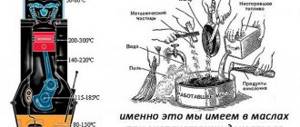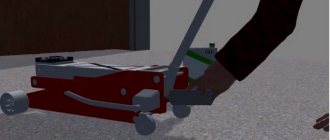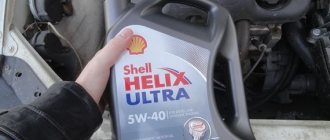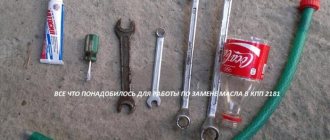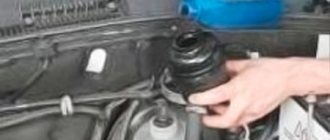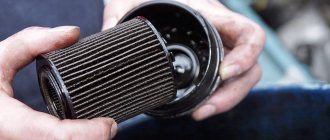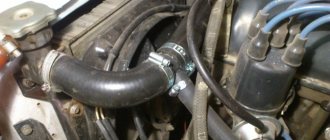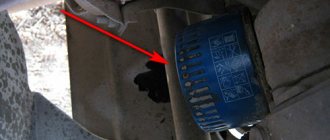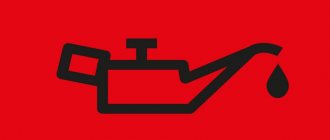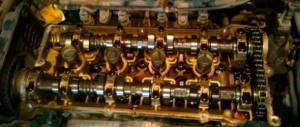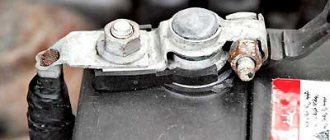10/11/2020 2,493 Cooling system
Author: Victor
The correct operation of a car engine depends on a number of factors, one of them is the circulation of engine fluid and antifreeze through the internal combustion engine and cooling system. Mixing of substances may be the result of a serious problem that will lead to inoperability of the unit. For what reasons does oil appear in antifreeze and how to solve the problem, you will learn from this article.
[Hide]
Reasons for oil getting into the cooling system
Oil in expansion tank with antifreeze
First, let's look at the reasons why motor lubricant got into the engine. They are relevant for all types of engines, diesel and gasoline, regardless of the make of the car, be it a VAZ, Mercedes or KamAZ. Both types of liquids circulate through closed, impermeable and isolated systems. Therefore, the appearance of a lubricant in the refrigerant indicates a malfunction. A violation of the tightness will lead to the inoperability of the power unit in the future.
The main reasons why oil went into antifreeze and ended up in the cooling system:
- violations of the integrity of the cylinder head gasket associated with wear or other problems;
- mechanical defects in the operation of the radiator or cooling device;
- water pump failure;
- damage or wear of the heat exchanger gasket;
- the appearance of a crack in the refrigerant container;
- natural wear or defect of cooling system hoses;
- rust formation on cylinder head liners.
Sometimes the reason why antifreeze can get into the lubricant lies in the inadequacy of the fluids used in the car. When the level of refrigerant in the system decreases, car owners often fill the tank with the first available coolant. Due to the different composition of liquids and additives in antifreeze, chemical reactions can occur that lead to the destruction of certain components of the internal combustion engine. These are the main reasons why oil can get into antifreeze.
You will learn more about the reasons for mixing substances from the video made by user Ruslan Yashchishin-KATMASTER.
How to determine whether oil is entering the expansion tank or not?
As mentioned earlier, the presence of oil in the expansion tank is indicated by a dirty neck of the container and a change in the structure, smell and color of antifreeze. But these are not the main symptoms of a breakdown. It can also be determined by the following factors:
- when draining the coolant, its condition is not in doubt, but after the procedure is completed, a dark-colored liquid with a pungent odor begins to flow out of the system;
- soot may begin to settle inside the expansion tank;
- The antifreeze level decreases quickly.
There is another unique way to find out whether oil has appeared in the cooler. To do this, take a small piece of clean cloth, dip it in antifreeze poured into the expansion tank, and try to set it on fire. Does not burn? This means that only refrigerant is present in the system. If even a small fire appears, you can be sure that oil has entered the cooling system.
It is impossible to completely protect your car from breakdowns, because they appear at the most unexpected moment, and sometimes you can only guess about their causes. However, a car enthusiast can reduce the risk of unpleasant situations if he handles the car more carefully. In cases where oil gets into the cooling system, it is clear that depressurization is to blame. And in order to avoid a recurrence, this depressurization should first be eliminated.
How to determine?
Let's look at how to recognize and determine that lubricant is getting into the coolant.
The main signs indicating a problem:
- When the refrigerant is drained, the color and consistency are correct. But when all the liquid has drained into the container, a mixture of antifreeze and lubricant will come out of the hole, more viscous and oily in appearance. If you check the condition of the substance in the expansion tank, this may not be noticed.
- When mixing different chemical liquids, an oily film appears in the tank.
- The mixture will feel greasy to the touch and can be easily smeared with your fingers, but it will not leave any traces.
- The lubricant always burns. Therefore, if you take a rag or napkin and dip it into the reservoir under the hood, and then set it on fire, it will ignite. During combustion, a barely noticeable crackling sound will be heard. If you try to set fire to a piece of paper or a piece of cloth soaked in antifreeze, then nothing will work. And when performing this procedure with clean lubricant, the napkin will flare up quickly.
- When you open the filler cap, you will see that there are soot clots in the oil. In this case, there will be deposits in the channels of the lubrication system. This leads to a decrease in the throughput of the filter mechanism.
- When mixing, the filter itself becomes clogged with dense balls. The result is complete clogging of the device and abrasive wear of the cylinders, as well as bearings, crankshaft and camshaft.
- The appearance of corrosion inside the power unit. It is impossible to diagnose this problem without disassembling the engine.
- Reduced antifriction characteristics of engine oil.
- The film on the lubricant will be unstable, and at the slightest impact it will begin to tear.
The result of mixing coolant and lubricant
The appearance of antifreeze in oil: what are the signs?
The first thing a motorist should be concerned about when he notices that the coolant is decreasing is where it accumulates or where it ends up. Of course, if there are no obvious signs of antifreeze leaking under the vehicle (it is dry underneath), but the liquid disappears, then you should pay attention to signs that show that antifreeze is getting into the oil. The presence of the following signs allows you to quickly determine why the coolant level changes sharply.
- Antifreeze is visible on the oil level dipstick
The engine runs unevenly when idling. The car is getting damaged.
- When checking the oil level, the dipstick showed drops of antifreeze.
- The upper liquid level quickly tends to the minimum.
- Detection of unusual antifreeze drips under the head.
- At high speeds, air bubbles are observed in the expansion tank.
- Oil streaks are visually visible on the outer wall of the expansion tank.
- Traces of coolant are visible on the crankcase.
- Change in color of antifreeze. Over several months it becomes significantly darker and fades, even to black.
- When examining the spark plugs and their seating grooves, traces of coolant are found.
- Increased exhaust concentration - carbon monoxide in the expansion tank exceeds the permissible content.
- Coolant accumulates in the pan.
Solution
Let's take a closer look at what to do if oil gets into the refrigerant.
If problems arise with mixing, the first thing to do is flush the cooling system.
If the reason lies in the appearance of defects on the cylinder head gasket, then you will have to remove the cylinder head and replace the damaged part. This procedure is best left to professionals.
What will you need?
To flush the cooling system you will need:
- new antifreeze that matches the parameters of the car;
- an old bucket or basin for collecting waste substances;
- approximately 15 liters of distillate;
- gasket for cooling device.
User Lesha Master showed on the video how to properly flush the system.
Step-by-step instruction
You need to clean the power unit as follows:
- If you have a special flushing agent, pour it into the expansion tank with coolant. Start the engine and wait until it warms up, this is required to start the radiator ventilation device. The flushing procedure is performed before replacing the oil cooler gasket.
- Unscrew the coolant drain plug, first placing a container under it into which the waste will flow. Wait until all the antifreeze has left the system.
- Remove the oil cooler. The dismantling procedure differs depending on the car, so we will not describe it. Before removal, study the service book to take into account all the nuances. After disassembly, clean the device. Worn gaskets and sealing components are removed and new ones are installed in their place. Parts are purchased taking into account the model and design features of the machine.
- After replacing the seals, remove the antifreeze reservoir located under the hood. Clean it, remove all deposits and dirt inside. If the container has cracks, it is recommended to replace it.
- After draining the old refrigerant and washing the tank, the cleaning process is performed another 2-3 times, depending on the amount of contamination. The reservoir is installed in place and the distillate is poured into it. The engine starts, but the heater must be turned off. Activate the radio, optics, interior lights and other energy consumers, this will allow the unit to reach operating temperature faster. As the engine heats up, the radiator fan will turn on. After this, turn off the power to all devices. Run the stove to maximum to cool the machine engine and turn off the ventilation device.
- Allow the unit to cool, this will take about 15 minutes. Open the drain plug and drain the distillate. If it is very dirty and has traces of deposits, wash it again. The procedure is repeated until the liquid draining from the cooling system is clean. The presence of traces of oil in the mining is not allowed.
- Screw the drain cap back into place and fill the system with new refrigerant. Antifreeze is selected in accordance with the technical parameters of the internal combustion engine. This may be G11, G12 or G13 standard fluid. Check in the service book; it usually contains the manufacturer's recommendations.
- Start the engine again and rev it up. By increasing the speed of the unit, press on the hoses of the cooling system, this will remove air. Please note that the expansion tank cap must be tightened when removing air plugs, but when pressing on the pipes, it should be opened from time to time.
Photo gallery
Photo on cleaning the cooling system of a car.
1. Remove the heat exchanger located next to the BC
2. Clean the device and replace the gasket
3. Remove the container and rinse it thoroughly
4. Clean the cooling system
Consequences of mixing oil and antifreeze
If the oil goes into Antifreeze or another refrigerant, and the problem is not solved in a timely manner, this is fraught with the following consequences:
- Wear of bearing devices. Due to the mixing of liquids of different chemical compositions, corrosion occurs on the metal elements of the motor, and since all rubbing components, including bearings, are subject to high loads, this leads to rapid wear of parts.
- Motor jamming. This problem is more relevant for diesel units. As a result of mixing substances, rust forms on the internal walls of the internal combustion engine, which leads to damage. After using the car, when the engine cools down, some of the refrigerant may enter the combustion chamber. When the internal combustion engine is subsequently started, the coolant density will be reduced, which will lead to jamming of the unit and the need for expensive repairs.
- Clogged oil filter device. As a result of mixing additives of different compositions, soot appears and settles on engine elements. The filter becomes clogged with sediment particles and wear products, resulting in the need to replace it. But changing just the part itself is not enough; it is necessary to identify and eliminate damage through which the refrigerant enters the internal combustion engine. After this, the lubrication system is cleaned by flushing the engine. If you simply change the filter device and add new lubricant, the deposits will quickly clog the filter, and you will still have to completely solve the problem.
The consequences of mixing antifreeze and oil
The result of engine contamination with a mixture of two technical fluids will depend on the duration of exposure. First, coking of the bearings occurs, deposition of sticky oil on the internal parts, and corrosion. If you do not pay attention to the signs of malfunction for a long time, then eventually the engine will seize and then only a major overhaul will bring the engine back to life.
When buying a car, be prepared for the fact that you will have to do basic maintenance yourself. Moreover, all recommendations are described in the operating instructions. Having studied the basic knowledge of the machine's structure, you are unlikely to manage to pour coolant into the lubrication system. And knowing how to determine antifreeze in oil, you will not miss an insidious problem.
Video:
Video:
Video:
